You are here
New Releases
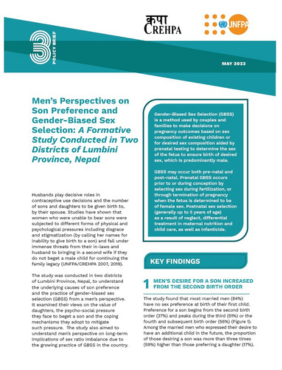
Policy Brief: Men’s Perspectives on Son Preference and Gender-Biased Sex Selection
Husbands play decisive roles in contraceptive use decisions and the number of sons and daughters to be given birth to, by their spouse. Studies have shown that women who were unable to bear sons were subjected to different forms of physical and psychological pressures including disgrace and stigmatization (by calling her names for inability to give birth to a son) and fall under immense threats from their in-laws and husband to bringing in a second wife if they do not beget a male child for continuing the family legacy (UNFPA/CREHPA 2007, 2019).
This policy brief is based on a study conducted in two districts of Lumbini Province, Nepal, to understand the underlying causes of son preference and the practice of gender-biased sex selection from a men’s perspective.
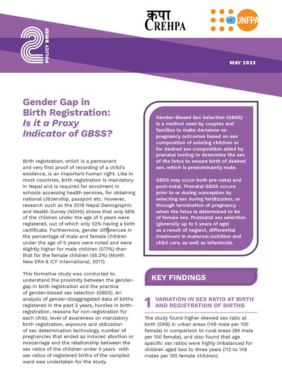
Policy Brief: Gender Gap in Birth Registration and the Practice of Gender- Biased Sex Selection
Birth registration, which is a permanent and very first proof of recording of a child’s existence, is an important human right. Like in most countries, birth registration is mandatory in Nepal and is required for enrolment in schools accessing health services, for obtaining national citizenship, passport etc. However, research such as the 2016 Nepal Demographic and Health Survey shows that only 56% of the children under the age of 5 years were registered, out of which only 52% having a birth certificate. This formative study was conducted to understand the proximity between the gendergap in birth registration and the practice of gender-biased sex selection.
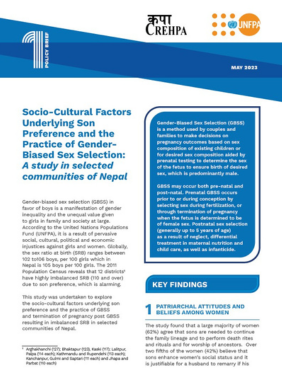
Policy Brief: Socio-Cultural Factors Underlying Son Preference and the Practice of Gender- Biased Sex Selection
Gender-biased sex selection in favor of boys is a manifestation of gender inequality and the unequal value given to girls in family and society at large. According to UNFPA, it is a result of pervasive social, cultural, political and economic injustices against girls and women. Globally, the sex ratio at birth ranges between 102 to106 boys, per 100 girls which in Nepal is 105 boys per 100 girls. The 2011 Population Census reveals that 12 districts have highly imbalanced sex ratio at birth (110 and over) due to son preference, which is alarming. This policy brief was developed based on studies conducted to explore the socio-cultural factors underlying son preference and the practice of gender-biased sex selection in Nepal.
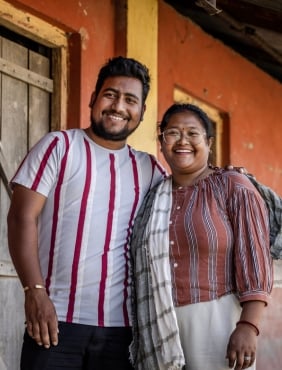
16 stories of change
The UNFPA-led Gender-Based Violence Prevention and Response (GBVPR) Phase II Project has made a tangible difference in the lives of individuals and communities across Koshi and Sudurpaschim Provinces.

12th National Population and Housing Census 2021
The National Statistics Office of the Government of Nepal released the results report of the 12th National Population and Housing Census 2021 Report in March 2023. It has also launched a innovative data portal at https://censusnepal.cbs.gov.np/results
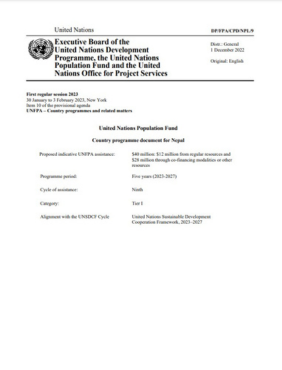
UNFPA Country Programme Document for Nepal (2023-2027)
The vision of the ninth new country programme (2023 - 2027) is to accelerate the achievement of universal access to sexual and reproductive health and reproductive rights, with a focus on reducing preventable maternal deaths, unmet need for family planning, gender-based violence, child marriage and other harmful practices.
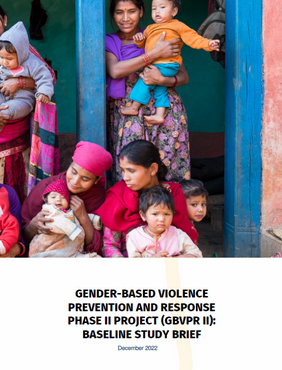
Gender-based Violence Prevention and Response - Baseline Study Brief
This is the brief of the baseline study conducted under the Gender-based Violence Prevention and Response (GBVPR II) Project that UNFPA implements with funding from the Swiss Agency for Development and Cooperation (SDC) and the Royal Norwegian Embassy of Nepal (RNE) in 19 municipalities in Province 1 and Sudurpaschim Province from 2020 - 2024. The study was conducted in partnership with Emory University.
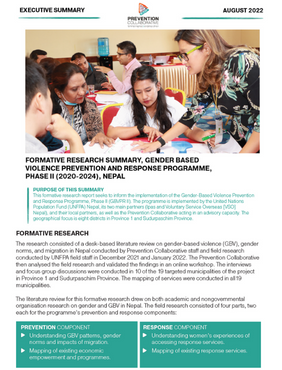
Formative Research Summary - GBVPRII
This formative research report seeks to inform the implementation of the Gender-Based Violence Prevention and Response Programme, Phase II (GBVPR II 2020-2024) - a flagship project implemented by the United Nations Population Fund (UNFPA) Nepal.
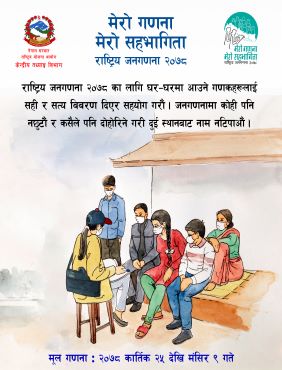
Nepal Census 2021 message cards
The main census enumeration commenced on 11 November across Nepal. The Central Bureau of Statistics (CBS) has worked tirelessly since 2018 to ensure that the census preparations were thorough. UNFPA commends the management of CBS for persevering despite the challenges posed by the COVID-19 pandemic to organize the census in 2021, which will raise consistency with earlier censuses.
These digital messages have been jointly produced by CBS and UNFPA to provide relevant information to promote people's participation in the census.
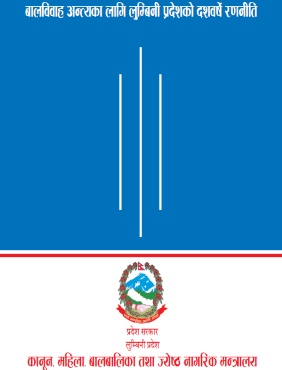
Lumbini Province: Strategy on Ending Child Marriage
On 12 November 2021, the Provincial Government of Lumbini Province launched a strategy to end child marriage. The Ministry of Law, Women, Children, and Senior Citizens of Lumbini has called for cooperation from concerned organisations and public to end child marriage in the province through the successfull implementation of the 10-year strategy.
Developed with support from UNFPA, the strategy aims at working with local governments and partners in Lumbini to educate, aware and empower children and their parents on the importance of ending child marriage through imparting skill-based training and conducting community-level awareness campaigns. It also aims at generating research and analysis to identify the existing problems in order to enable the concerned authorities and agencies to chart out an action plan against child marriage.
Nepal has one of the highest rates of child marriage in Asia – for both girls and boys. Although the legal age of unions for both sexes is 20, more than a third of young women aged 20-24 report that they were married by the age of 18, and just over one in ten by 15. Nepali boys are among the most likely in the world to be child grooms. More than one in ten is married before they reach 18.Child marriage is a human rights violation, restricting children’s choices, changing their course in life, and putting them at significant risk of abuse and violence.
In 2016, UNFPA and UNICEF launched a global programme to tackle child marriage in 12 of the most high-prevalence or high-burden countries, including Nepal. Under the programme, UNFPA and partners are working together, among others, with adolescent girls and boys in their communities to empower and protect them.